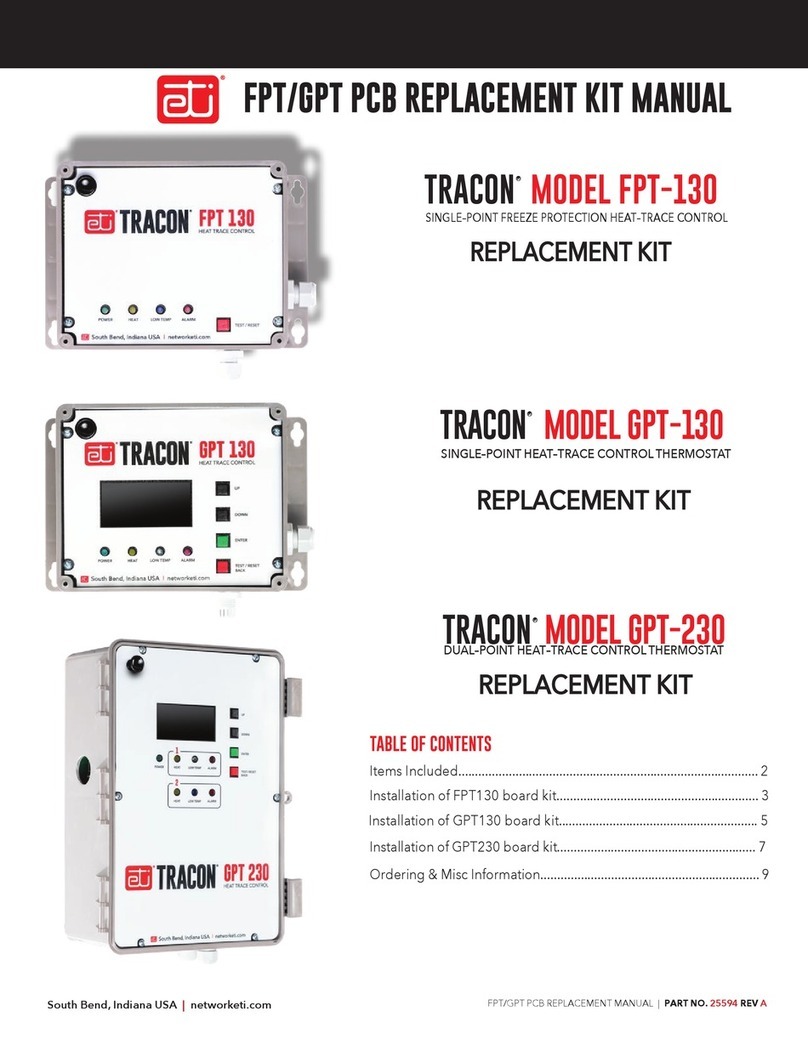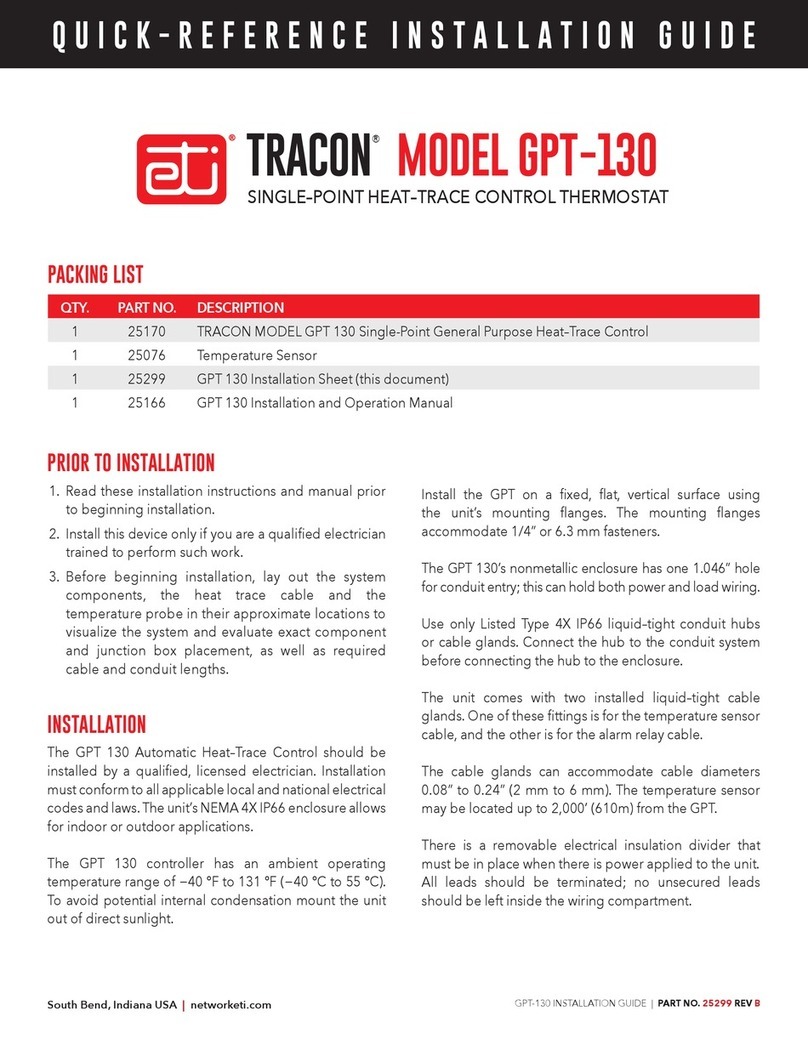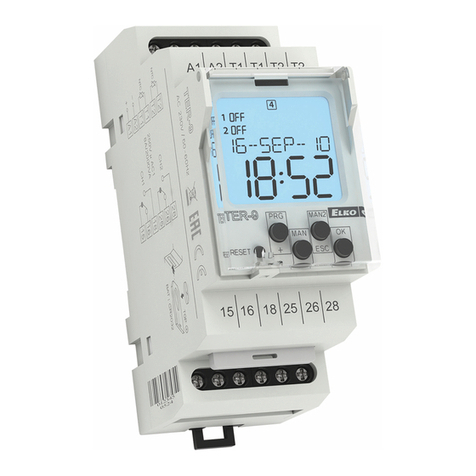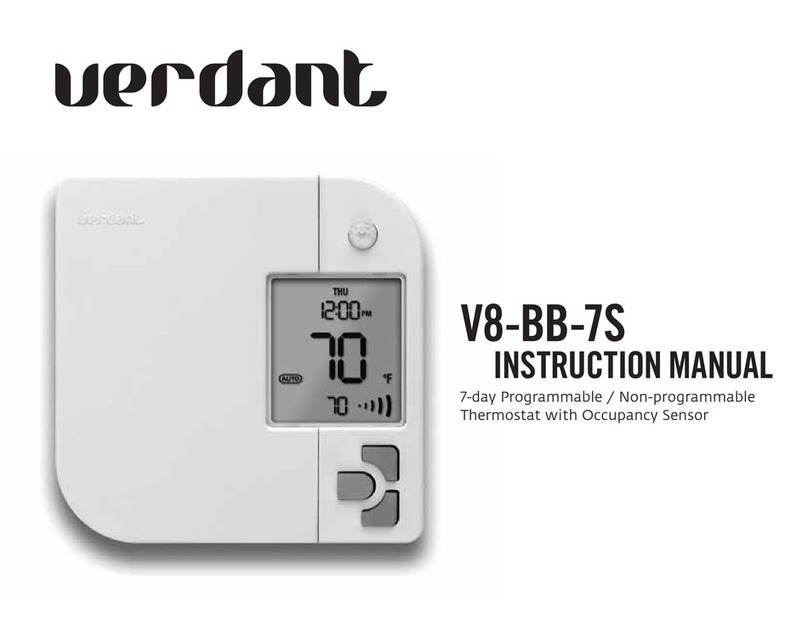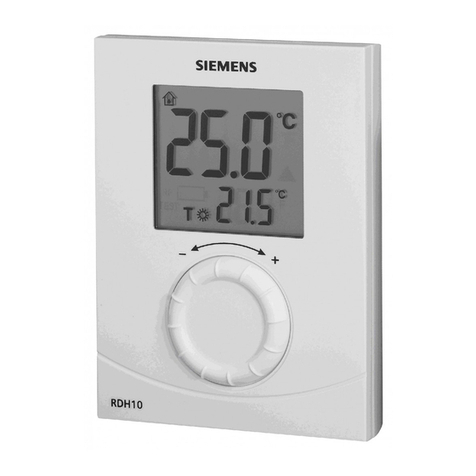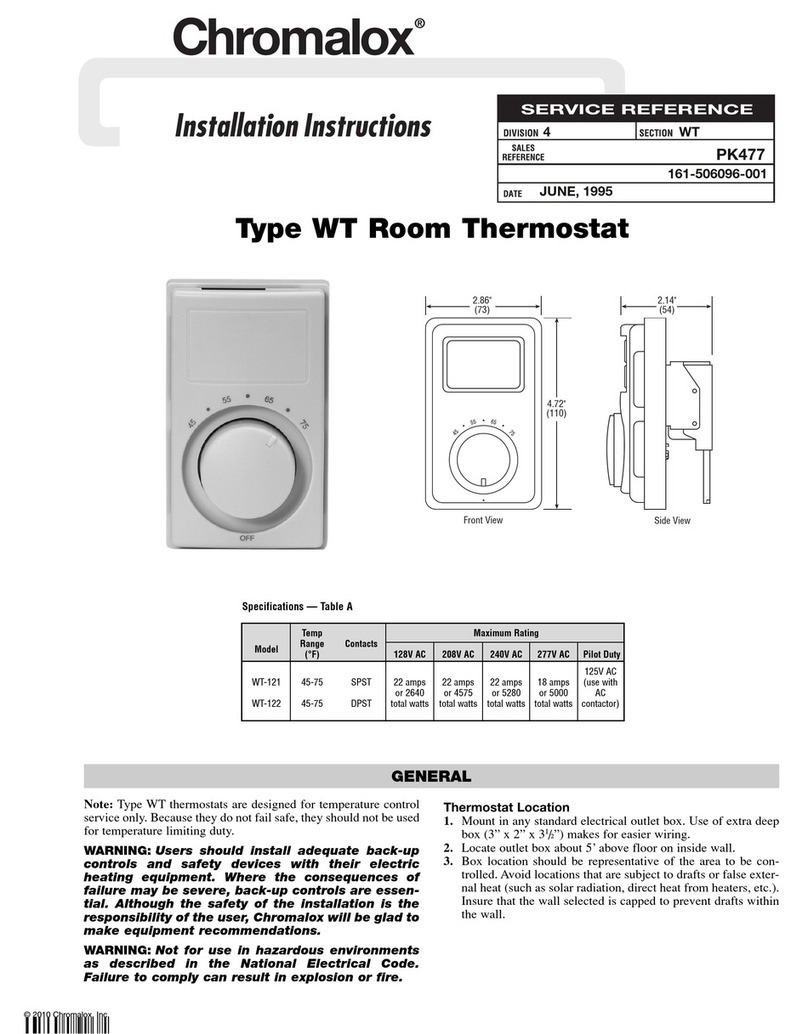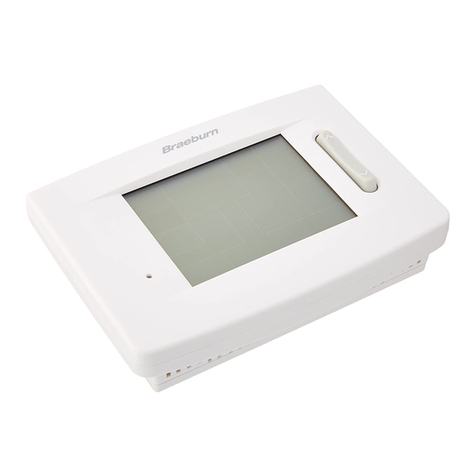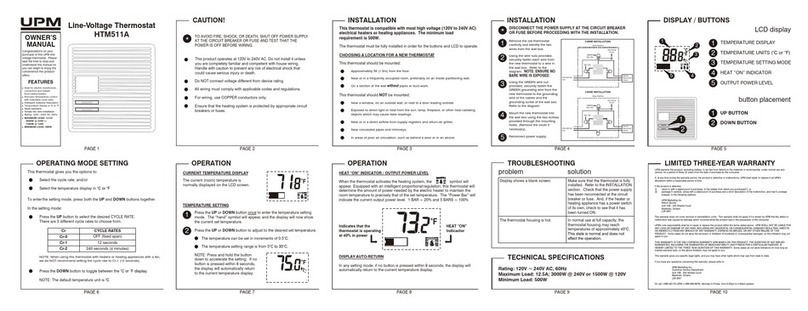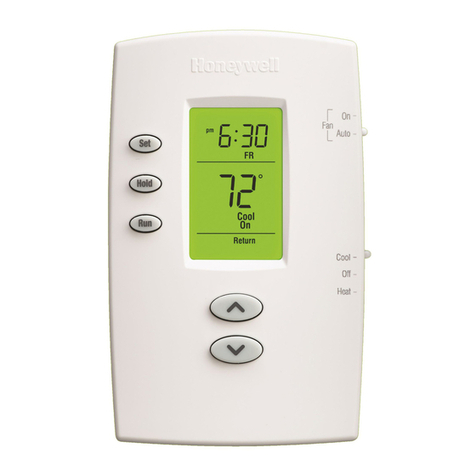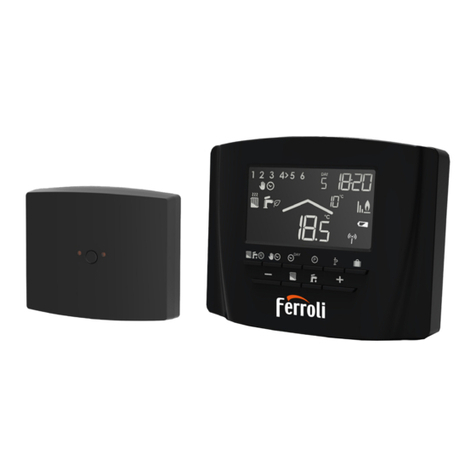ETI Tracon GPT 230 User manual

South Bend, Indiana USA | networketi.com GPT-230 INSTALLATION MANUAL | PART NO. 25167 REV C.1
TABLE OF CONTENTS
GPT 230 Overview................................................................................... 2
Installation ................................................................................................ 3
Power Source and Load Connections................................................... 4
Temperature Sensor Installation............................................................ 5
Panel Lockout and External Alarm ........................................................ 6
Operation ................................................................................................. 6
Controls and Screens.............................................................................. 9
Settings Screen Viewing/Editing Setting............................................ 10
Specications ......................................................................................... 11
Pilot Duty
The GPT 230 General Purpose Thermostat with GFEP cannot be used
for Pilot Duty applications.
Resistive Load Usage Only
This product is not for use with Inductive loads. Inductive loads
may create nuisance tripping of the Ground–Fault Equipment
Protection circuit.
Abnormal Odor or Smoke
In the event of smoke or a burning or abnormal odor, immediately
interrupt power to the unit by turning off the circuit breaker protecting
the unit.
Electrical Shock / Fire Hazard
Any installation involving electric heater wiring must be grounded
to earth to protect against shock and re hazard. Suitable ground
fault detection and interrupting systems must be in use at all times to
reduce shock and re hazard and to protect equipment.
Electric wiring to heating elements must be installed in accordance
with National Electrical Code (NEC)/Canadian Electrical Code
requirements, as well as all other local and applicable electrical
codes and any thirdparty standards. This product is intended for
commercial and industrial applications. Follow the installation
MODEL GPT-230TRACON
®
DUAL–POINT HEAT–TRACE CONTROL THERMOSTAT

South Bend, Indiana USA | networketi.com GPT-230 INSTALLATION MANUAL | PART NO. 25167 REV C.1
2
instructions contained in this manual and those provided
by the heater manufacturer.
Size the circuit breaker appropriately for the expected
load and inrush current. The maximum rated current for
the GPT 130 is 30 amps with resistive load.
Heater loads and their controls should not share a circuit
branch with other types of equipment. A shared circuit
may result in electromagnetic interference that can affect
system operation.
Make certain that the heater shield is properly grounded.
Failure to do so may result in damage to the equipment
or re.
Following installation and prior to beginning system
operation, refer to and perform the Post-Installation Test
described in this manual.
ITEMS INCLUDED
QTY. P/N DESCRIPTION
1 25171 TRACON MODEL GPT 230
Dual-Point General Purpose
Heat–Trace Control
2 25076 Temperature Sensor
1 25300 GPT 230 Installation Sheet
1 25167 GPT 230 Installation and Operation
Manual (this document)
OVERVIEW
The TRACON GPT 230 Dual Channel Heat–Trace Control
is a dual–point microprocessor–based heat–trace control
thermostat. It is ideal for applications which require two
independent heater–control Channels with Ground–
Fault Equipment Protection (GFEP). Ideal uses include
freeze protection, hot water temperature maintenance,
grease line trace, tank heating, and other temperature
monitoring and control applications. The GPT 230 and its
heater load can be powered with an available line voltage
source of 100 – 277 V ac. The controller and heater load
are powered from the same supply connection. The
two internal load contactors are rated to switch up to
30 A resistive. The adjustable GFEP function provides
additional safety and compliance with national and local
electrical codes. The unit’s housing is a NEMA 4X IP66
weather–resistant enclosure for enhanced durability.
FEATURES AND BENEFITS
• Dual channel heat trace capabilities allows for complete
control and monitoring of two separate channels from
one unit
• Adjustable temperature setpoint allows precise control
of a wide range of processes
• Can use NEC Class 2 temperature sensors with up to
2,000 ft. cable for enhanced installation options
• Two thermistor temperature sensors with 20 ft. cables
included for applications of −40 °F to 230 °F (−40 °C
to 110 °C)
• RTD input allows higher accuracy and extreme–
temperature applications
• The unit can accommodate RTD sensors with 2–, 3–, or
4–wire conguration
• Temperature display for accurate adjusting and
monitoring
• Load current display for accurate adjusting and
monitoring
• Ground fault current display for accurate monitoring,
protection, and alarm
• Adjustable alarm thresholds for excess ground fault
current, load current, and temperature
• Alarms indicated with panel display and relay contact
for remote signaling
• A Fault Mode setting which can be set to energize or
de-energize the heaters during a sensor failure
• Fire Protection Mode maintains heater operation for
use in critical re protection systems
• Durable weather–resistant NEMA 4X IP66 enclosure
permits indoor or outdoor installation

South Bend, Indiana USA | networketi.com GPT-230 INSTALLATION MANUAL | PART NO. 25167 REV C.1
3
FIGURE 1. The GPT 130 wiring layout
The GPT 230 is permanently connected equipment and
does not have an internal disconnect device. The installer
must provide an accessible disconnect device, with
short circuit and overcurrent protection (these are not
supplied by Environmental Technology Inc). When power
is applied, the system will start.
INSTALLATION
The GPT 230 Dual Channel Automatic Heat–Trace Control
should be installed by a qualied, licensed electrician.
Installation must conform to all applicable local and
national electrical codes and laws. The unit’s NEMA 4X
IP66 enclosure allows for indoor or outdoor applications.
The GPT 230 controller has an ambient operating
temperature range of −40 °F to 122 °F (−40 °C to 50 °C).
To avoid potential internal condensation mount the unit
out of direct sunlight.
Install the GPT on a xed, at, vertical surface using
the unit’s mounting anges. The mounting anges
accommodate 1/4” or 6.3 mm fasteners.
Use only Listed Type 4X IP66 liquid–tight conduit hubs
or cable glands. Connect the hub to the conduit system
before connecting the hub to the enclosure.
The GPT 230’s nonmetallic enclosure has two 1.046”
holes for conduit entry; this can hold both power and load
wiring. The installer can cut a second hole in the bottom
or right, for separate line and load conduits.
The unit comes with two installed liquid–tight cable
glands. These ttings are for temperature sensor and
alarm relay cables.
The cable glands can accommodate cable diameters
0.08” to 0.24” (2 mm to 6 mm). The temperature sensors
may be located up to 2,000’ (610m) from the GPT.
There is a removable electrical insulation divider that
must be in place when there is power applied to the unit.
All leads should be terminated; no unsecured leads
should be left inside the wiring compartment.
FIGURE 2. Mounting Dimensions

South Bend, Indiana USA | networketi.com GPT-230 INSTALLATION MANUAL | PART NO. 25167 REV C.1
4
POWER SOURCE AND CONTACTOR CONNECTIONS
Supply Voltage
The GPT 230 operates from 100 – 277 V ac at 50/60
Hz. This control and its heater load should not share a
circuit branch and circuit breaker with other types of
equipment.A shared circuit may result in electromagnetic
interference that can affect system operation. For line
supply and load connections, use 10 AWG wires rated
for at least 194 °F (90 °C). The connections are shown in
Figure 3 and Figure 4.
Contactor Ratings
The heater contactor provides two (2) Form A (DPST)
contacts rated for heater loads up to 30 A ac and 277 V ac.
These two contacts are used to control both legs of the
input power (Line and Neutral).
Manual Load Test
To manually energize the load, select the Settings screen
and then hold Test/Reset pushbutton for ve seconds.
The output will switch on and stay on for ve minutes or
until Test/Reset key is pressed again. A manual load test is
recommended upon installation to verify heater function
and load current.
FIGURE 3.1
Contractor
Connections
FIGURE 3.2
Contractor
Connections
FIGURE 4.1
Connection
Schematic
FIGURE 4.2
Connection
Schematic

South Bend, Indiana USA | networketi.com GPT-230 INSTALLATION MANUAL | PART NO. 25167 REV C.1
5
TEMPERATURE SENSOR
Each channel of the GPT 230 can use either a thermistor
(provided), or a 2–,3–, or 4–wire RTD sensor. When using
an RTD sensor, three DIP switches must be set to match
the type of wiring connection. When using Sensor Sharing
(see page 11), one sensor, connected at channel 1, is used
to control both channels.
Thermistor (25076)
The GPT 230 comes with two Thermistor temperature
sensors with 20 ft. jacketed cables that have an operating
range of −40 °F to 230 °F (−40 ˚C to 110 ˚C). See Figure 5
for proper wiring when using thermistor sensors.
RTD
The unit can use RTD sensors for applications requiring
a wider temperature range. The GPT 230 can operate
with 2–, 3–, or 4–wire RTD sensors. See Figure 5 for proper
wiring and DIP switch congurations when using a 2–, 3–,
or 4–wire RTD sensor.
Note: The sensor must be selected in the Sensor Type
parameter setting screen also.
FIGURE 5. Temperature sensor wiring and DIP switch congurations

South Bend, Indiana USA | networketi.com GPT-230 INSTALLATION MANUAL | PART NO. 25167 REV C.1
6
PANEL LOCKOUT
To prevent unauthorized changes of control settings, the
fourth DIP switch can be set to the on position to Lock the
settings. With Lock enabled, the control panel will allow
viewing but not changing any of the settings; only the °C
or °F option can be changed. See Figure 6.
Note: The GPT reads the Lock DIP switch position when
the Settings screen is entered. If the switch is changed,
you need to re-enter the Settings screen.
EXTERNAL ALARM
Alarm Connections
An alarm or power–off condition can be communicated
by either opening or closing a relay contact. It is important
to make the proper alarm relay connections to achieve
the desired result. The middle terminal labeled COM
(Common) is used in both wiring congurations. Connect
one alarm relay lead to the COM terminal.
If the system needs a contact to close to signal an alarm or
power–off condition, connect the other alarm relaylead to
the NC (Normally Closed) terminal. See Figure 7.
If the system needs a contact to open to signal an alarm
or power–off condition, then connect the other alarm
relay lead to the NO (Normally Open) terminal.
If the unit has power, and there are no alarm conditions
then the NO and COM terminals will be connected. If the
unit loses power or an alarm condition occurs then the
NC and COM terminals will be connected.
Note: The “Normally” condition of the relay is the alarm
condition for the unit.
OPERATION
The GPT 230 can maintain temperatures from a setpoint
ranging from −99.9 °F to 999.9 °F (−73.3 °C to 537.7 °C).
The usable temperature range is sensor dependent. The
heater will energize when the temperature drops below
the designated setpoint. The heater will de-energize when
the temperature meets the designated High Temperature.
The GPT 230 features ETI’s patented self–testing
GFEP, which switches the system off when it detects
excessiveground current leakage. The GFEP eliminates
the extra expenses associated with having to provide an
external GFEP.
Alarms
Critical Alarms are Latching alarms and include Ground
Fault, High Current, Stuck Relay, Internal Circuit, and
FIGURE 6. Panel lockout DIP switch conguration
FIGURE 7. External alarm connection

South Bend, Indiana USA | networketi.com GPT-230 INSTALLATION MANUAL | PART NO. 25167 REV C.1
7
Power Fail. Critical alarms always turn off the heat, unless
Fire Protect Mode is ON. To continue normal operation,
any of these will require a manual reset. The manual reset
(TEST/RESET BACK pushbutton) will start a self test, and
if all Critical Alarms are cleared then normal operation
will resume.
Non-critical Alarms can be Latching or Non-Latching
depending on the Latching setting alarms and include
Low Current, Low Temperature, High Temperature,
and Sensor Fault. A Sensor Fault will stop temperature
regulation (with heat on or off depending on the Fail
Mode setting), but as soon as the sensor is corrected,
then operation will immediately resume. The other Non-
critical Alarms do not inhibit operation.
Note: Latching alarms require manual clearing to resume
operation.
The Manual Self Test clears all alarms, checks Ground
Fault Current, and checks Low Current if the Low Current
delay is set to ve seconds or less. The Auto Self Test does
not clear alarms, but otherwise functions the same as the
Manual Self Test.
GPT 230 Front Panel
Indicator Lights (See Figure 8.)
• POWER indicator – This green LED indicates that the
GPT 230 is receiving power.
• HEAT indicator – This yellow LED indicates when the
heater is energized.
• LOW TEMP indicator – This blue LED indicates when
sensors detect temperature has fallen below the Low
Temp Alarm threshold.
• ALARM indicator – This red LED indicates when there is
high ground fault current detected or any other alarm
condition exists.
Note: Because the unit has no ON/OFF power switch,
power runs to the unit as soon as facility power is
connected to it. When the unit has power, the green
POWER indicator will be lit.
GPT 230 CONTROLS AND SCREENS
CONTROLS
Pushbuttons
• UP and DOWN pushbuttons – These black pushbuttons
change the display and menu screens. They are also
used for changing settings or values within the menus.
• ENTER pushbutton – This green pushbutton is for
selecting and entering settings or values within the
menu.
• TEST/RESET BACK pushbutton – This red pushbutton
has the following functions:
– To test the ground fault detector circuit itself AND
to test for a ground fault when the heat load is not
energized (the heater will energize during the test).
This will also test for Low Current if the Low Current
delay setting is set to 5 seconds or less. Note:
whenever the heat is on, the unit is continuously
checking for a ground fault.
– To reset the system after a ground fault. If the ground
fault no longer exists, then normal operation will
resume.
– Clearing any other latched alarm conditions if the
alarm condition no longer exists.
FIGURE 8. GPT 230 front panel

South Bend, Indiana USA | networketi.com GPT-230 INSTALLATION MANUAL | PART NO. 25167 REV C.1
8
– On settings menus this pushbutton backs out of an
operation without changing anything.
– Energizes heater for system testing or troubleshooting.
Pressing this pushbutton for ve seconds while on
the Edit Settings screen will energize the heater for
ve minutes. Pressing the pushbutton again will de-
energize the heater and resume normal operation.
MAIN SCREENS
There are ve main screens that can be accessed using
the UP and DOWN pushbuttons. These screens cycle in
the sequence shown in Figure 9; pressing UP or DOWN
ve times returns you to your starting position.
Note: After initial use the default display screen when
left alone will be the last main screen that was displayed
for more than ve seconds.
Triple Display screen – Displays the three data elds
(Temperature, Load Current, Ground Fault Current) are
all shown on this same screen. If there is an alarm, the
eld description will alternate with an alarm notication.
In most cases, the alarm on this screen will identify
what the alarm is, except for a Load Current alarm. To
determine whether the Load Current alarm is a high or
low Load Current alarm you must view the Load Current
Display screen.
Temperature Display screen – Indicates the current
temperature in Fahrenheit or Celsius. This screen will also
show any associated alarm conditions.
Load Current Display screen – Indicates the load current
to the heaters in amps. This screen will also show any
associated alarm conditions.
Ground–Fault Current Display screen – Indicates the
ground fault current in milliamps. This screen will also
show any associated alarm conditions.
Note: In any of the main sequence screens, pressing
the TEST/RESET BACK pushbutton will clear all latched
alarms and perform a self–test, including a ground fault
current test. The “Passed” or “Failed” result of the self–
test is then displayed, then returns to the default screen.
Settings screen – Allows access to all the parameter
settings. The top line will say “Edit Settings” or “View
Settings”, depending on whether the Panel Lockout
function is set with the internal DIP switch (see page 7).
With Panel Lockout enabled, most conguration settings
can only be viewed, not edited. The only exception is the
choice of Celsius or Fahrenheit temperature units.
Note: The GPT reads the Lock DIP switch position when
the Settings screen is entered. If the switch is changed,
you need to re-enter the Settings screen.
FIGURE 9. Main screen sequence

South Bend, Indiana USA | networketi.com GPT-230 INSTALLATION MANUAL | PART NO. 25167 REV C.1
9
GPT 230 SETTINGS SCREEN VIEWING/EDITING SETTINGS
SETTINGS SCREENS
To enter the Settings sequence press the ENTER
pushbutton while in the Settings screen. This will take
you to the Settings sequence, where you can view or
edit system parameter settings. These screens follow the
sequence shown in Figure 10; pressing the UP or DOWN
pushbuttons 21 times returns you to your starting position.
Note: The Settings screens cycle a circular sequence. The
rst time the Settings sequence is accessed the sequence
will start with the Sensor Sharing screen, every time after
that when accessed the Settings sequence will start with
the Control Temps 1 screen.
Each screen has a line at the top which describes the
parameter or group of parameters. Press the ENTER
pushbutton to edit the parameter or group of parameters.
If the Panel Lockout feature is turned on you will see a
screen that says “Edit Function Locked Out”. The BACK
pushbutton will take you back to the default screen.
All settings are stored in the unit’s non-volatile memory,
this means that the GPT 230 will retain the inputted
settings even if the unit looses or is disconnected from the
power source. Holding the UP and DOWN pushbuttons
together for ve seconds will restore all settings to their
factory default value.
Basic Editing of Settings
When on the desired screen press the ENTER pushbutton
to edit the values. Use the UP and DOWN pushbuttonsto
change the parameter values, press the buttons quickly to
change the number values decimally, or hold thebuttons
to scroll through the number values more quickly. The
ENTER pushbutton saves the value setting. TheBACK
pushbutton cancels the edit operation if not saved and
returns to the original value at the start of the edit.
Multi-eld Screen Editing
In screens that display multiple elds, there are two
columns. The left column displays the name of the
parameter, and the right column displays the current
value. Initially, one of the elds in the left column will be
selected (have a selection box around it). Use the UP and
DOWN pushbuttons to change the row which is selected.
Press the ENTER pushbutton to edit the parameter in
that row, the selection box will move to the right column,
indicating that an edit operation is in process. After you
are done editing, press the ENTER pushbutton to save the
new value, or the BACK pushbutton to make no change.
The selection box will move back to the left column.
Alarm Options Screen Editing
The “Alarm Options” screen has three binary (on/off)
conguration settings:
Latching: this controls whether non-critical alarms latch.
When ON, alarms need to be cleared manually by using
the red key. When OFF, the alarm will go away when the
alarm condition resolved. The default for the Latching
setting is OFF.
Fail Mode: this is a safe state setting which can be set to
energize or de-energize the heaters if the sensor fails. The
default setting for the Fail Mode is ON.
Fire Prot: this controls whether the Fire Protection mode is
active. When ON, a ground fault or over–current alarm will
not inhibit operation of the heater. When OFF, a ground
fault or over–current alarm will de-energize the heater.
The default setting for the Fire Protection mode is OFF.
When in the edit mode the description and meaning of the
currently selected parameter is displayed at the bottom. As
you edit the value, the description will change accordingly.
Note: To restore all settings to factory default press both
the UP and DOWN pushbuttons together for ve seconds.

South Bend, Indiana USA | networketi.com GPT-230 INSTALLATION MANUAL | PART NO. 25167 REV C.1
10
FIGURE 10. Setting screen sequence
SETTING SCREENS
Note: Screens with a number “1” in the upper right corner indicate that these settings are for Channel 1. There is a
second set of these screens for Channel 2 which have a “2” in the upper right hand corner. The Channel 2 Settings
screens will follow the Channel 1 Settings screens in the Settings sequence.

South Bend, Indiana USA | networketi.com GPT-230 INSTALLATION MANUAL | PART NO. 25167 REV C.1
11
SPECIFICATIONS
General
Certications UL 60730–1, UL 1053,
CSA E60730–1:13
Environmental
Area of use Nonhazardous locations
Operating temperature range −40 °F to 122 °F (−40 °C to 50 °C)
Enclosure
Dimensions 9.0” (W) x 12 4/5” (H) x 5 9/10” (D)
2229 mm (W) x 325 mm (H) x
150 mm (D)
Ingress protection NEMA 4X, IP66
Cover attachment Polycarbonate cover, plastic screws
Cable entries Two liquid–tight cable glands installed
for sensor and alarm leads, cable
diameter 0.08” to 0.24” (2 mm to 6
mm) One 1.046” hole to accommodate
a ¾” conduit tting for power wiring
connection
Material Polycarbonate
Weight 5.8 lb. (2.63 kg)
Mounting Wall mount with anges
Wiring Terminal Ratings
Power Barrier Strip Terminals for Line, Neutral,
and Ground; use 10 AWG wires rated
for at least 194 °F (90 °C)
Sensors Terminal Block, rising cage clamp,
12–28 AWG leads
Alarm relay Terminal Block, rising cage clamp,
12–28 AWG leads
Parameter Settings
Temperature setpoint heat ON Adjustable −99.9 °F to 999 °F (−73.3
°C to 537.7 °C) Default 38 °F (3.33 °C)
Temperature setpoint heat OFF Adjustable −99.9 °F to 999 °F (−73.3
°C to 537.7 °C) Default 40 °F (4.44 °C)
Low–temperature alarm
threshold −99.9 °F to 999 °F (−73.3 °C to 537.7
°C) Default 35 °F (−1.7 °C) Disabled
Low–temperature alarm delay 0 s to 3000 s Default 300 s
High–temperature alarm
threshold −99.9 °F to 999 °F (−73.3 °C to 537.7
°C) Default 140 °F (60 °C) Disabled
High–temperature alarm delay 0 s to 3000 s Default 300 s
Low–current alarm threshold 0.0 A to 10.0 A Default 0.1 A Enabled
Low–current alarm delay 0 s to 300 s Default 5 s Enabled
High–current alarm threshold 0.0 A to 55.0 A Default 30.0 A Disabled
High–current alarm delay 0 s to 600 s Default 300 s
Ground fault limit current 1.0 mA to 300.0 mA Default 30 mA
Self–Test Interval 1 h to 250 h Default 24 h Enabled
Temperature Unit °F or °C Default °F
User Interfaces
Pushbuttons UP, DOWN, ENTER, TEST / RESET
BACK
DIP switches RTD wiring conguration
Panel lockout
Remote Interface
Alarm relay Isolated SPDT 1 AMP Class 2
contact per channel
Indicators
Status indicator Power (Green)
Heater (Yellow)
Low Temperature (Blue)
Summary alarm (Red)
Display 2.7” OLED graphic 128x64
Summary alarm relay reporting Low temperature
High temperature
Low load current
High load current
High ground fault current
Stuck relay
Sensor fault
Internal fault
Control Ratings
Temperature accuracy +/− 2 °F (1 °C)
Temperature Sensors
Temperature inputs (Included) Thermistor: 100k ohms
at 25 °C, range −40 °F to 230
°F (−40 °C to 110 °C), 20ft Lead
(25076) RTD Sensor: Platinum,
Alpha = 0.00385, ITS–90,100 ohms
at 0 °C, Input supports 2-wire,
3-wire, or 4–wire connection,
Sensor operates at 1 mA
GFEP (Ground–Fault
Equipment Protection)
Operation Continuously tests ground fault
current whenever the load is on;
also manually and periodically tests
equipment ground fault current
with each self–test.
Range Adjustable 1 mA to 300 mA,
Default 30 mA
Automatic self–test Veries GFEP functionality every
24 hr. and whenever the load is
energized
Power
Supply voltage 100 – 277 V ac 50/60 Hz
Controller power consumption 7 W maximum, 2.2 W idle
Load rating 30 A, 100 – 277 V ac resistive

South Bend, Indiana USA | networketi.com GPT-230 INSTALLATION MANUAL | PART NO. 25167 REV C.1
12
ORDERING INFORMATION
Part Number Description
25171 TRACON MODEL GPT 230 Dual-Point
General Purpose Heat–Trace Control
25076 Temperature Sensor
25300 GPT 230 Installation Sheet
25167 GPT 230 Installation and Operation
Manual (this document)
CONTACTING CUSTOMER SERVICE
For assistance, contact Customer Service. Ofce hours are
from 8:00 AM until 5:00 PM ET.
Email: [email protected]
Web: networketi.com
Mail: ETI
1850 North Sheridan Street
South Bend, IN 46628
RETURNS AND REPLACEMENT PART PURCHASES
Equipment cannot be returned for credit once it has
been installed. ETI will repair or replace faulty equip-
ment under warranty. Prior to removal of equipment for
warranty return, please contact ETI Technical Support for
troubleshooting assistance.
Before returning a unit to ETI, obtain a Return Merchandise
Authorization from our Customer Service Department,
available between 8:00 a.m. and 5:00 p.m. Eastern Time. If
possible, use the original container and packing materials
when packing the unit for shipment. It is important to
mark the Return Merchandise Authorization clearly
on the outside of the shipping container so that it may
be correctly processed upon receipt at Environmental
Technology. For more information about replacement
parts or for a replacement Data Sheet or Manual, please
visit www.networketi.com.
LIMITED WARRANTY
ETI’s two year limited warranty covering defects in
workmanship and materials applies. Contact Customer
Service for complete warranty information.
DISCLAIMER
ETI makes no representations or warranties, either
expressed or implied, with respect to the contents
of this publication or the products that it describes,
and specically disclaims any implied warranties of
merchantability or tness for any particular purpose. ETI
reserves the right to revise this publication, and to make
changes and improvements to the products described
in this publication, without the obligation of ETI to notify
any person or organization of such revisions, changes or
improvements.
Copyright © 2019 ETI,
®
All rights reserved.
Other manuals for Tracon GPT 230
1
Table of contents
Other ETI Thermostat manuals
Popular Thermostat manuals by other brands
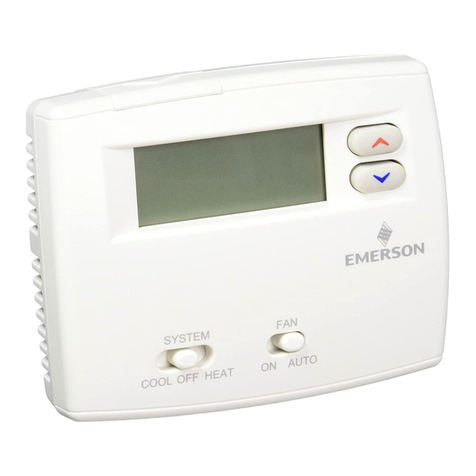
Emerson
Emerson 1F86-0244 instructions
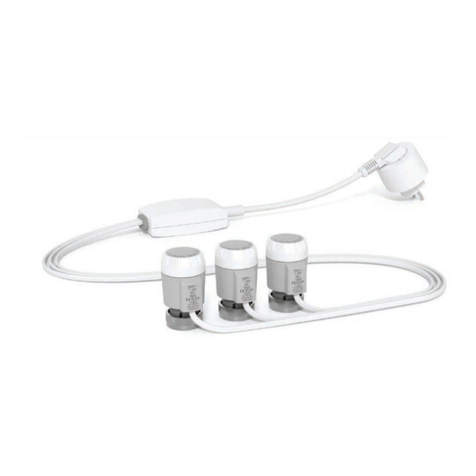
Plugwise
Plugwise Koen quick start
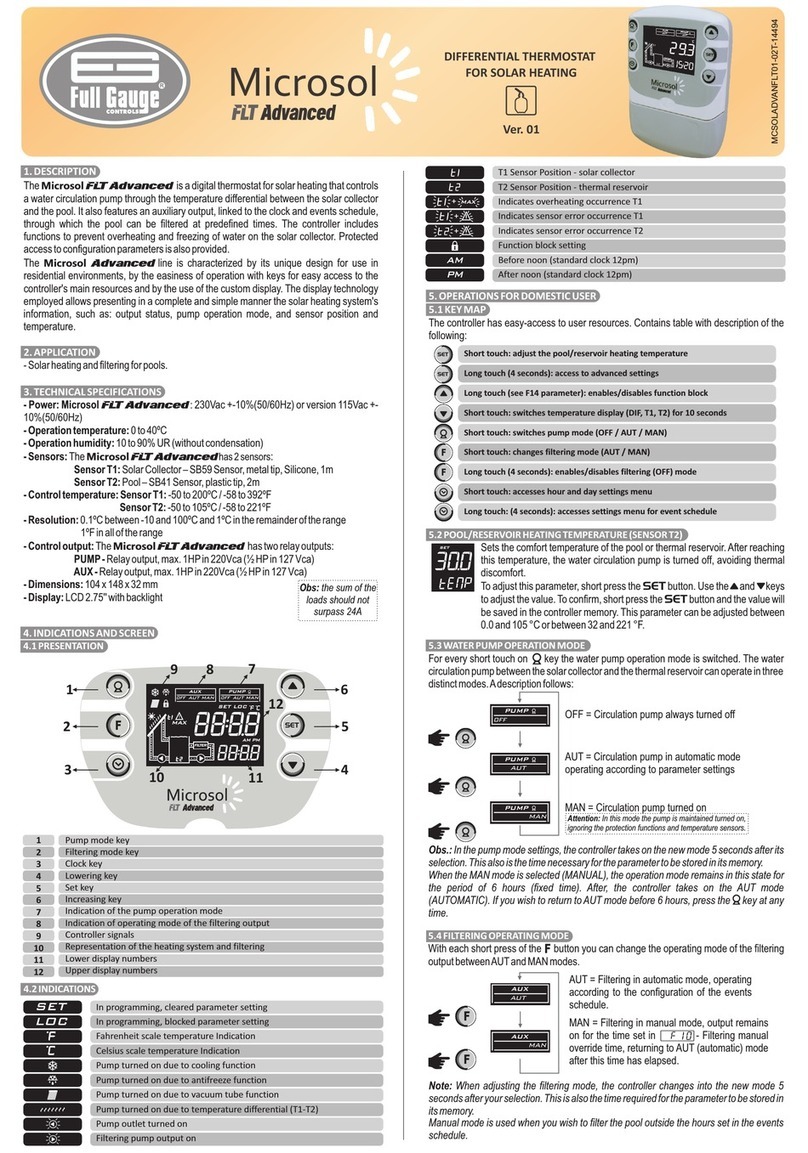
Full Gauge Controls
Full Gauge Controls Microsol FLT Advanced quick start guide

Honeywell Home
Honeywell Home HumidiPRO H6062 installation instructions
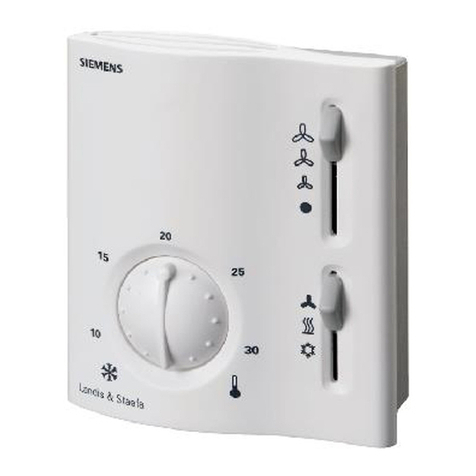
Siemens
Siemens RAB10 Series Technical instructions
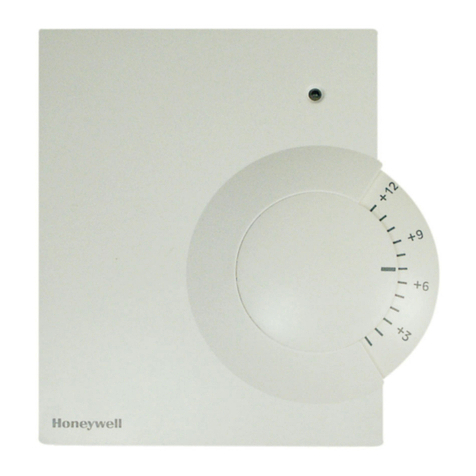
Honeywell
Honeywell HCW 80 Installation and operation
